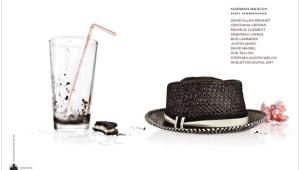Business Trends
What Photo Clients Want, A Survey
| Photography is about commerce. There are photographers and photography clients. It's a two-party system! To be commercially successful, no matter what you do as a photographer, your challenge is to understand what photo clients need and what they want when they buy photography. When I saw the work PhotoSource International had done for their "client survey," I contacted them. Director Rohn Engh generously referred me to the author of the survey, Mikael Karlsson, to get a preview of the survey results for this column. The answers clients gave may be a validation of what you already know, but they may also change the way you are handling your self-promotion. This is important information, so read carefully. Here, your clients are telling you how to sell to them. First, Engh is a veteran editorial stock photographer selling to national and worldwide markets since 1960. Many stock photographers today can attribute their early interest and training to Engh's book, Sell & Resell Your Photos, a popular best-seller from Writers' Digest books. He is founder and publisher of Photo-StockNotes, PHOTOLETTER, and Photo-Daily (see his homepage at www.photosource.com). Engh also conducts photography-marketing seminars nationwide. He and his wife, Jeri, a free-lance writer, work out of their barn-office in Osceola, Wisconsin. For information on his free newsletter PhotoAimLite see www.photoaim.com/lite/order.html Karlsson has been a professional photojournalist for 13 years and does both the photography and the writing for his articles. He has worked in more than 30 countries, extensively in the Middle East, Australia, and all across Europe covering everything from breaking news to features. Currently he is the US correspondent for 11 major Swedish national magazines and a regular contributor to several American magazines. Karlsson is the author of Stock Photography 101, the PhotoSource Starter Kit, and the PhotoSource International 2001 PhotoBuyer Survey. He lives with his wife Ruth, two dogs, and one horse in an old farmhouse on a small acreage in rural Nebraska. Here is the link to the PhotoSource Survey 2001 order form: www.photosource.com/101/survey.html. Karlsson tells us some of the important findings in the client survey. Shutterbug: From the client survey, what should photographers remember to do and not to do when contacting a new client? Mikael Karlsson: Here is a list of things the clients mentioned to do and not to do:
1. Pay attention to detail and try to establish a dialog with the photo buyers you are working with. 2. Target your submissions. If you shoot only close-ups of flowers or cute and cuddly animals, chances are rather slim that you'll get any photos sold to Time or Newsweek. 3. Specialize. General photos are hard, if not nearly impossible, to sell. The more you know about your market, the more sales you are likely to make. 4. Make things easy for the photo buyers. Put together an information package about the photos you have to offer and send that, preferably along with some sample images, to photo buyers who have expressed an interest in your work.
1. Send unsolicited photo submissions. Of the photo buyers that took part in the PhotoSource Survey 2001 90 percent stated that they do not want unsolicited submissions. 2. Use second rate anything when it comes to promoting your business. If you can't afford to have professional looking stationery printed by a professional printer, hold off for a while until you can. Remember that you'll never, ever get a second chance to make a first impression. 3. Promote yourself at random. It is far better to make a professional mailing to 10 photo buyers who have a continuing need for the kind of photos you make than 2000 letters sent to randomly selected photo buyers. 4. Spam photo buyers with messages like, "Visit my web site and browse through the 300 pictures I have up there." Photo buyers, like all other professionals, are busy people and you need to make it easy for them to do business with you. SB: What do clients suggest is the best way to submit photos to a new client or market? MK: Find out how the client wants you to submit. Good communication is the key here. Before submitting any photos to a new client or market, the photographer needs to spend some time doing homework. Study the photos they are buying and make sure your photos are what the client is interested in. Then, check the client's web site for their "submission guidelines." Many clients in editorial, publishing, and fine art publish the submission guidelines they want you to follow. If you can't find this vital document on the web, call or write the client and ask. If they have it, ask for a copy and don't forget to enclose a self-addressed stamped envelope when you are asking in writing. When you have the guidelines, make sure you read them, understand them, and respect them. If a client specifies that they "want only 35mm slides" don't even think about sending prints or digital submissions without first checking with the client, via e-mail, letter, or fax. The responses we got from the photo buyers for the survey clearly states that, in most cases, unqualified submissions are frowned upon. So, the best thing to do is to find out as much as possible about a prospective client before submitting any images at all. SB: What kind of photo delivery methods do clients now prefer? MK: This varies greatly from photo buyer to photo buyer. Duplicates or originals sent by courier are still the most common method, but digital delivery is closing in. Quite a few photo buyers stated that many photographers still seem to have a lot to learn when it comes to scanning and digital delivery. The most common complaint voiced when talking about digital delivery was poor scans and low overall quality. The vast majority of photo buyers did say that they are growing very fond indeed of e-mailed previews they receive before they decide which images they want to view on their light box. SB: What kind of self-promotion material from a photographer works best from the client's point of view? MK: Tear sheets, post cards, and promo sheets in combination with available stock photo lists. Avoid poor quality ink jet prints. Naturally, the key here is to send samples that the client not only can but also wants to keep in his or her files. If you send a post card promotion and the client puts your card up on the office wall, you have hit the nail squarely on the head. Some photo buyers do not want tear sheets and only accept stock lists, while others toss stock lists and collect tear sheets with squirrel-like frenzy. The most common marketing material is still tear sheets and promo sheets, but just because it is common doesn't mean that all photo buyers will welcome it with open arms. In my opinion, the most important thing for any photographer interested in selling their photos is to take things nice and slow. Looking, listening, and learning are all great ways of breaking in or improving your sales. |
- Log in or register to post comments
















































